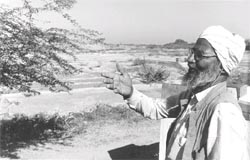Creating water scarcity
 If you want to see how water scarcity is created, pay a visit to Gaffurbhai Allahrakhha. Right since he learned to walk, he has been the caretaker of a shrine of a saint, built on the embankment of Boda Talaab, a pond in Surendranagar town of Gujarat. Although hardly anybody stops by to talk to him and ask him how he is doing, his 60-year-old eyes, hidden behind a broken pair of glasses, are chronicles of the town's history.
If you want to see how water scarcity is created, pay a visit to Gaffurbhai Allahrakhha. Right since he learned to walk, he has been the caretaker of a shrine of a saint, built on the embankment of Boda Talaab, a pond in Surendranagar town of Gujarat. Although hardly anybody stops by to talk to him and ask him how he is doing, his 60-year-old eyes, hidden behind a broken pair of glasses, are chronicles of the town's history.
He clears his throat, and begins to talk: "This pond is 300-400 years old and was built by very intelligent people. It has a very large catchment area. If it rained several kilometres away, the water would come here. If it rained properly, it would have water for two years. It would sustain all the people and livestock of the neighbouring area. Farmers used to take three crops as this pond used to make water available in the wells.'
Pointing to the building of C U Shah Diploma Engineering College on the other side of the embankment, he says, "This college came up a few years ago. It has cut off the pond from its catchment area. The pond remains dry for most of the year now. And the water goes into the town, stagnating in residential areas and providing an abode to malaria-spreading mosquitoes. The sahibs probably sit in the college and discuss water scarcity. Their throats parched, the animals are staved off by the barbed wire put by the forest department along the embankment. Now, they say this pond useless. They might reallocate the land, I gather. Too bad.'
Also meet the Maldhari nomad Sangrambhai Heerabhai Rabari of village Mahali in Radhanpur taluka, Banaskantha district, Gujarat. He does not remember his age
Related Content
- Order of the National Green Tribunal regarding illegal mining and unlawful encroachments in the Katli river, Rajasthan, 15/03/2024
- Order of the National Green Tribunal regarding heavy withdrawal of water from Yamuna affecting the river, 04/12/2023
- Blockchain and IoT for drinking water in G20 countries: a game-changing opportunity
- Order of the National Green Tribunal regarding extraction of groundwater for commercial purpose, Ghaziabad area, Uttar Pradesh, 03/01/2023
- Water quality assessments for urban water environment
- Creating an ecosystem for increasing water-use efficiency in agriculture
